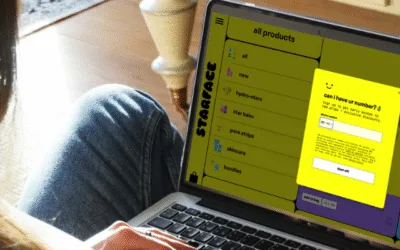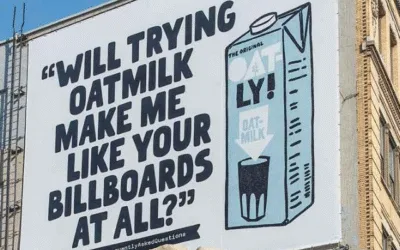Peachies beat Pampers by selling sleep, not nappies. Learn their Ladder of Why messaging trick to make your copy resonate.
Why “talking like your customer” can backfire (and how we helped Animal avoid it)
Speaking like your audience is a great way to win customers. But it's easy to go a bit OTT and lose your personality. Learn how to nail it 👇
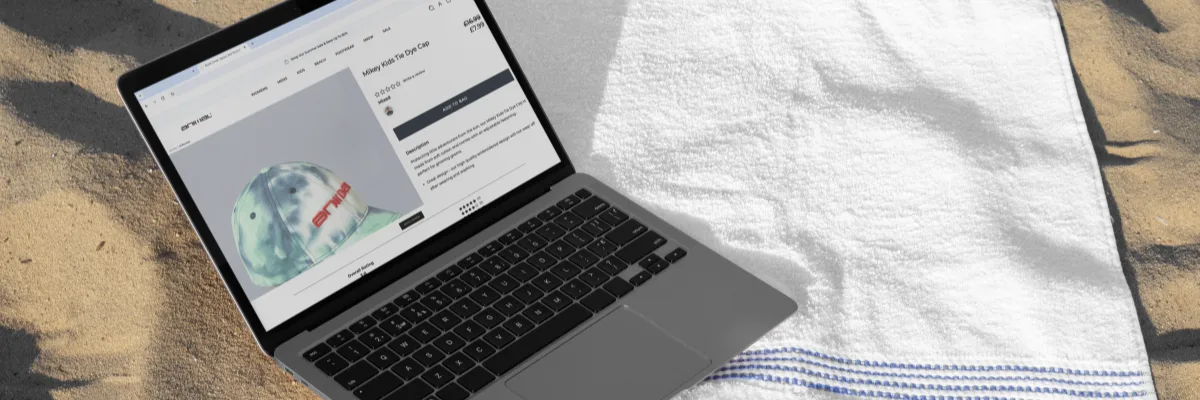
Get pro copy tips, branding tricks and e-comm insights directly to your inbox every Tuesday.
This week’s big idea: Mirror your audience’s language, but leave room for your own individuality.
“There is your audience.
There is the language.
There are the words that they use.”
Eugene Schwartz, OG copywriter
In copywriting, one of the easiest ways to go from “a brand” to “the brand” is using a little sprinkle of something called linguistic style matching (LSM).
Basically, speak the way your target audience speaks.
In fact, a growing body of research says that matching the language with the way your customers speak can build trust with your audience super-fast.
👉 Rodríguez-Díaz et al. (2022) showed that when your copywriting style and word choices match the linguistic style of your audience (in tone, syntax, even rhythm) they become more persuasive and lead to greater customer satisfaction post-purchase (AKA, better reviews, less returns and more social proof.)
👉 Professors John Bryden, Sebastian Funk and Vincent Jansenfound that social tribes naturally develop unique vocabularies to signal who’s “in” and who’s not, even down to unusual spellings, emoji choice and punctuation style.
👉 A meta-analysis of Amazon listings published in the Journal of Marketing found that when the language and tone of product descriptions feels in sync with the way the reviews are written, there’s an increase in conversion, attention, and message recall.
In other words, when brands talk like us, we feel drawn to them.
This is because, psychologically, when someone (even a brand) starts using our kind of language — things like sentence length, rhythm, even filler words — we subconsciously feel closer to them.
(It’s why even the FBI use it to negotiate hostage releases because it improves the chance of a successful negotiation.)
This whole concept is called Communication Accommodation Theory and it’s been the case since we left the caves and developed language. We adapt the way we talk to bond with people faster and create connections.
Which is why it’s a good idea for brands to adjust and adapt to the way their audiences talk.
However, as recent studies have found, trying too hard to adjust your communication style is more likely to backfire than to win you customers.
As a 2025 Journal of Marketing study found, brands that try to shoehorn in slang or youth language (like “rizz” or “slaps”) can backfire.
Audiences rated those brands as less authentic, less likeable, and less trustworthy, even when they were using the “right” words.
(Which, funnily enough was the exact response my 9 year old had when I asked him “Is this dinner straight fire? Does it slap? Do I have the rizz?”)
So, how do we speak our customers’ language to make more sales without undermining our authenticity, trust and likeability?
Let’s dig into it 👇
Let’s start by walking you through how I helped a UK lifestyle brand find that balance
A good few years ago, I helped relaunch the voice and copy of Animal, a much-loved UK surf brand (based up the road from me in Poole 🤙 ) that had been part of the scene since the ‘80s.

But, after decades of success, they’d hit a bit of a wall. Sales were falling off, they’d just been acquired and, like a lot of heritage brands, they were trying to figure out how to stay relevant and top of mind in a more crowded market without losing what made them, well, them.
(We talked about this last week, too. As spaces become more crowded, you really have to work to make sure customers still see what makes your brand special. I can see eco brands kinda entering that space right now, so it’ll be interesting to see which brands pull away from the pack messaging-wise.)
They reached out and asked me to help revamp their brand voice so they could:
a) establish who they are again
b) make sure they were being consistent across their messaging
c) reaffirm their connection with the community they’d been a huge part of for decades.
So, I got to work reading every surfer forum and community I could find to immerse myself in the lingo. I had calls with their pro surfers about what Animal meant to them. I spent a load of time rereading old Animal copy while I bobbed my head to Jack Johnson.

After a while, a few things had jumped out:
👉 In their early days, Animal’s voice had been more laid back and chill. You could almost smell the salty air and the board wax in their writing. But their current site had lost a lot of that tone in favour of a more run-of-the-mill voice.
👉 There was a mismatch between how Animal spoke and how their audience spoke. Their audience’s language was dynamic, had energy and had a strong love of nature and exploration running through almost everything they wrote. (Even the reviews they left were less about the product and more about how the product helped them be out on the waves.)
👉 On a vocabulary level, I also noticed some timeless surf slang that cropped up in the early Animal days and that their audience still used. Namely that younger surfers are called groms (or grommets) and that almost every single person we spoke to used the word “stoked”.
So, we decided to go back to the brand’s roots a bit and realign their voice with their audience.
We massively scaled back the corporate tone (because “copy that sells” doesn’t have to mean bland, formulaic copy) and leaned into a more languid, laid back, surfer-y tone again.
We dialed up the sense of exploration and adventure, like in all of the reviews. Now, we weren’t describing the products so much as the adventures and activities the customers could do in the products.
And, as a rule, “kids” became “groms.” And if the brand were excited about anything, they were “stoked”.
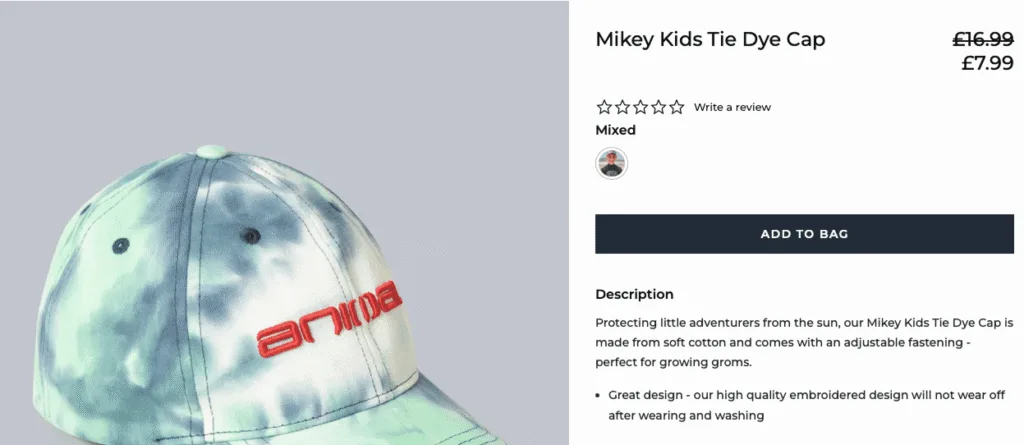
Look at the difference it made 👇
Before: “This tee brings a bit of cool that every boy will be excited to wear all winter long.”
After: “This tee brings a touch of salt-sprayed cool that your grom will be stoked to wear all year long.”
We’ve literally changed three words there.
But the top one could be written by any brand at all.
The other feels like it came from a brand that spends its days out on the waves.
🏆 Bonus: groms is gender neutral too, so it’s a great bit of in-crowd and inclusive language!
But here’s the important thing: we didn’t just grab all of the surfer slang we found and run with it.
I found lots of instances of their audience using words like “sick” or “gnarly” or even the odd ironic “far out”.
However, once we tried them out in a few bits of copy, it was clear they didn’t line up with Animal’s brand identity.
Animal are OGs of the UK surf scene. They’d been sponsoring pro surfers and events and X-treme sports for decades at this point.
We didn’t want that very real heritage and history to be lost in a sea of slang that seemed like we were trying too hard to fit in or like they were newcomers trying to shout about how much they belong.
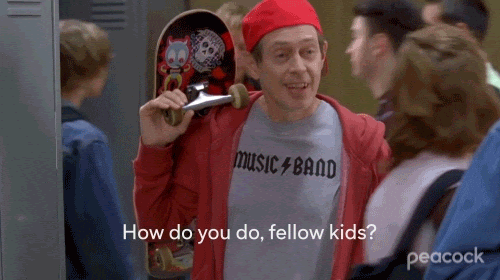
Which is exactly the lesson here.
There’s a super fine line between speaking like your audience and mimicking them. The sweet spot comes when you blend how you speak and what you believe as a brand with how your audience speak.
Why you need to balance fitting in with standing out (easy, right?)
This balance of fitting in and standing out simultaneously isn’t just a copywriting thing. It’s a human thing.
In 1995, psychologists Baumeister & Leary proved that humans are hardwired to seek out a sense of belonging. We need to feel part of something bigger than ourselves, so we mimic accents, we mirror body language, and we instinctively like people who talk like us, like the same stuff as us…
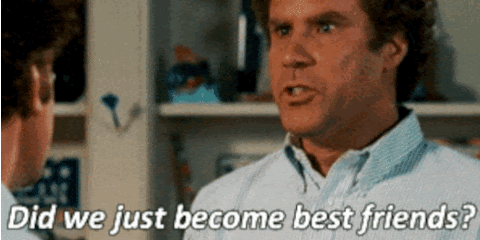
However, that’s only half the story.
Because after that, psychologists discovered something called Optimal Distinctiveness Theory, which said we’re constantly balancing two opposing needs: the need to belong and the need to stand out
If somebody is too similar to us? We feel like we don’t have our own identity.
Too much difference? We don’t feel that sense of belonging.
👆 And it’s why the best brands (just like the best people) feel like part of our crowd, but also have a little spark of something we don’t have. Something we want to borrow or bask in or strive to achieve for ourselves.
Think Patagonia talking how its customers talk about the planet but calling out the President. Think Oatly flashing its vegan credentials but in a way that’s full of sass and swagger…
And studies show that striking this balance in your copy and creative (AKA, a mix of fitting in and being a bit different) has a huge impact on the effectiveness of your communications.
When we see something novel, we pay attention and take it in. But when it communicates with us in a way that feels familiar, it’s easier to process, which we already know makes a big difference on whether people buy or bounce.
How to mirror your customers’ language without going full parrot
Learning how your customers speak and then weaving it into your copy is a pro-level copywriting move.
It makes a huge difference to the end result. It builds voices that are sticky and that audiences love.
And best of all? It’s dead simple to do.
Here’s how we do it
The easiest way to get started is to find where your target audience hang out or write online. Reddit threads, Amazon reviews, IG captions, Facebook comments, TrustPilot reviews…
Think places where your customers are relaxed, unfiltered, and most likely to let their real voice through.
We 🧡 starting on Reddit because it’s already split into tribes based on interest, so you can dive into niche subreddits and see how people talk when they’re ranting, raving, recommending stuff, hanging out…
(Pro tip: sort by “Top of all time” and head straight to the comment section—that’s where the gold is.) Within 30 minutes of digging, you’ll pick up vocabulary, sentence rhythm, inside jokes, emojis, slang.
But don’t start to analyse yet. Just absorb. Immerse yourself in it.
Amazon and TrustPilot are next. The review section isn’t just about stars, it’s where customers describe the impact your product has had in their own words. (Or, if they’re complaining about a competitor’s products, what they were expecting to get.)
👆 And that’s the stuff you want to borrow. Not just what your product is, but what it feels like to use or what customers want to feel about your product. Those reviews often have better headlines than the product pages themselves.
(We’ve talked about this before in more detail if you want to dig into it.)
Then head to Instagram, Facebook, X… and look to see if these patterns are still there.
Everywhere you go, make sure you’re starting to make a mental note of things like 👇
Phrases, sayings and slang that crop up again and again
These are your “we’re one of you” signals. Sprinkle them sparingly to show you get the tribe, but make sure they still feel like you. Avoid slang or words that just don’t feel right on a gut level.
How they describe using your product
This is gold for rewriting your PDPs, headlines, and landing page intros. Suddenly, you go from “our patented hydrating formula.” to “the cream that saves your face after a 10K in sideways rain.”
How they describe the life they want to live
This is the vision you’re selling, so weave it into benefit-led headlines and brand stories. Use your copy and social media captions to paint a picture of the life they want to live and position your product as a bridge from where they are to where they want to be.
How they talk about their pain points
You already know we’re not big fans of pain point-led copy. But that doesn’t mean that knowing how your audience talk about what bothers them doesn’t inform your writing. Pay attention to how they talk about their frustrations and then start to weave the flip side of that into your language. (e.g, let’s say you see a customer say “all adaptogenic coffees taste rank” then you can say something like “Finally, an adaptogenic coffee that you’ll enjoy drinking”.)
How they talk about people like them
Notice how your customers describe themselves. How do they signal what their “crowd” is like. Are they proud to be nerdy? Anti-mainstream? Loyal? Luxe? Foodies? This helps you write copy that builds affinity without feeling generic. (You can dig deeper on this too. Think last year’s brat summer trend, for example. That only worked for a specific kind of customer.)
How do they express emotion?
What do they say when they’re excited? What do they say when they’re frustrated? What slang do they use for things they love? Make a note of all of these, because emotionally-heightened words are absolute gold dust for writing copy that sells.
As you go through, remember: every little phrase is a clue to what matters to your audience, what resonates with them, and what your copy should sound like if you want to feel like part of the crowd.
But… don’t lose that sense of who your brand is in the mix. Remember: people like brands that are similar to them, not that are carbon copies.
So keep those strong opinions only your brand can say. Get weird with your phrasing. Be original.
And as you weave in customer lingo, ask yourself:
👉Does this word/phrase feel natural coming from us? Or does it feel a bit off?
👉 Would we say this in a customer email or out loud in the office?
👉 Is this adding to our brand voice or smothering it?
What to do if your voice is being drowned out by customer lingo
If you find that customer lingo is drowning your voice out a bit, here’s a pro tip: match the sentiment, not the style.
So if your audience says “this trail mix is giving me life” but that’s a bit too Gen Z for your brand, maybe say something like “The trail mix you’d hike 40 miles just to eat again.”
Same target audience. Same sentiment. But with your unique spin.
That’s mirroring not mimicking in action.
👆And that’s how you create a brand voice and copy that tells customers “we’re the brand for you” without coming across as try-hard or inauthentic.
As always, if your brand is taking that step from early stages to scaling up and you want a hand with your copy, messaging or figuring out your voice, we’d love to help. You can book a 15-min chat with us here to see if we’re a good fit!
Dive into more free tips and tricks 👇
How Starface use orthography to build a killer brand voice their customers love
The words you write matter. But so do your full stops, emojis and lowercase letters. Learn how to turn punctuation into a powerful part of your brand voice.
Why Oatly’s brand voice is so damn good (and how yours can be, too)
We dig into the three layers of brand voice (10,000ft, 1,000ft, ground level), show how Oatly nails each one and how you can do it for your own brand.
The weekly newsletter that takes your brand’s copy from “meh” to “hell f*cking yeah!”
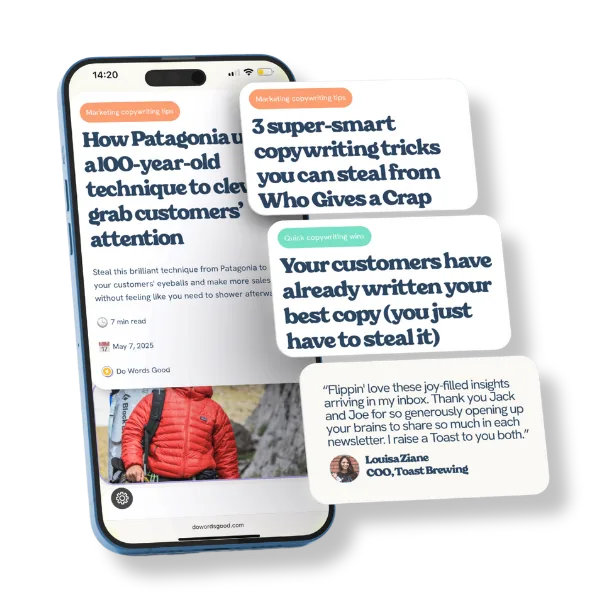
Read every week by legends at brands like these












